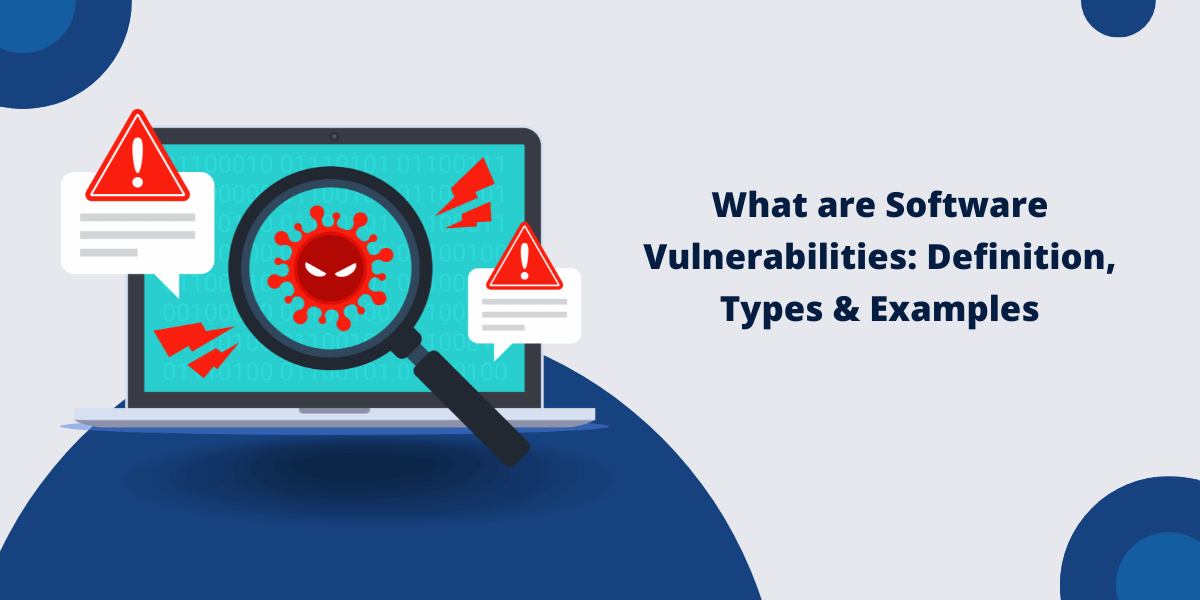What are Software Vulnerabilities?
Software vulnerabilities refer to flaws or weaknesses present in software programs, operating systems, firmware, and applications. These vulnerabilities arise due to weaknesses in the design, development, or configuration of the software.
The most common types of software vulnerabilities include:
- Buffer Overflows: Errors that allow attackers to overwrite memory locations, crash programs, or execute malicious code.
- Injection Flaws: Allow unauthorized insertion/execution of SQL, OS, or LDAP commands.
- Cross-Site Scripting: Enable attackers to inject client-side scripts into web pages.
- Broken Authentication: Flaws that compromise user login credentials and session management.
- Insecure Direct Object References: Expose unauthorized access to system files and resources.
- Cross-Site Request Forgery: Force users to execute unwanted actions on a web app they’re logged into.
- Unvalidated Input: Allow unauthorized input/commands due to lack of proper validation.
- Improper Access Controls: Incorrect permissions allowing unauthorized access to functionality.
- Cryptographic Failures: Insecure generation, storage, and transmission of sensitive data.
- Sensitive Data Exposure: Disclosure of private or privileged information in clear text.
Key Takeaways
- Software vulnerabilities are flaws or weaknesses that can be exploited to compromise a system. Common examples include buffer overflows, injection flaws, cross-site scripting, etc.
- Vulnerabilities can arise due to programming errors, design flaws, or misconfigurations. New vulnerabilities are constantly being discovered.
- Exploiting vulnerabilities can allow attackers to crash systems, access private data, take control of computers, or use them for illegal activities.
- Vulnerability scanning, penetration testing, bug bounty programs, and applying security updates are key ways to identify and address vulnerabilities.
- Developers should adopt secure coding practices, threat modeling, and remediation guidance to build more resilient software.
- Users should keep software updated, use antivirus tools and firewalls, and be wary of untrusted sources to prevent exploitation.
- Organizations need vulnerability management programs for asset inventory, risk assessment, lifecycle tracking, and timely remediation.
How Do Vulnerabilities Manifest in Software?
Vulnerabilities arise in software due to:
- Programming Errors: Bugs, flaws, or oversights in the source code during software design and development. Examples include – buffer overflows, SQL injection, and cross-site scripting.
- Design Defects: Architectural flaws, incorrect assumptions, or improper specifications in the software. For instance, always trusting inputs or inadequate encryption schemes.
- Misconfigurations: Incorrect security settings, unnecessary services running, using default passwords/keys. Makes the software prone to compromise.
- Unpatched Software: Running outdated software that contains known vulnerabilities for which fixes are available. An easy target for attackers.
- Integration Issues: Problems in interactions between different components, dependencies, and APIs of complex software.
- Poor System Administration: Inadequate access controls, account management, log auditing, or backup procedures.
- Malicious Insiders: Disgruntled employees or partners with access intentionally introducing flaws.
- Supply Chain Attacks: Compromising third-party software components or dependent infrastructure.
- Zero-Day Exploits: Sophisticated attacks targeting undisclosed vulnerabilities for which no patch exists yet.
- Insufficient Logging/Monitoring: Lack of visibility into assets, access patterns, anomaly detection, and mitigation.
What Risks Do Software Vulnerabilities Pose?
If left unaddressed, software vulnerabilities can impose significant cybersecurity risks, including:
- System Disruption: Exploits like denial of service can be used to crash systems and disrupt operations.
- Malware Infection: Malicious software like viruses, worms, spyware can be deployed onto vulnerable systems for continued exploitation.
- Data Breaches: Sensitive personal, financial, or strategic business data can be exposed.
- IP Theft: Source code, intellectual property, and trade secrets can be stolen.
- Financial Fraud: Vulnerabilities in web apps can enable attackers to steal funds.
- Compliance Violations: Exploitation can lead to violation of regulations like HIPAA, PCI-DSS, and GDPR.
- Reputation Damage: The public disclosure of vulnerabilities and breaches causes a loss of customer trust.
- Service Outages: Vulnerabilities in critical infrastructure can cause extended disruptions of essential services.
- System Takeover: Total compromise of systems for illegal use as botnets, crypto mining activities, etc.
- Escalation of Privileges: Flaws that allow lower-privileged users to gain administrative access to systems.
- Physical Damage: In ICS/SCADA systems, some vulnerabilities can cause equipment failure and physical damage.
What are the Common Sources of Software Vulnerabilities
Software vulnerabilities stem from various sources, including:
- Programming Errors: Bugs in coding lead to flaws like buffer overflows, injection attacks, cross-site scripting, etc.
- Design Weaknesses: Architectural weaknesses, vague specifications, incorrect design security assumptions.
- Configuration Mistakes: Incorrect software security configurations, such as unnecessary services, ports, and privileges, are enabled.
- Third-Party Flaws: Vulnerabilities arising from the use of third-party libraries, components, and dependencies.
- Legacy Systems: Old systems lack the latest security features yet are integral to operations.
- Human Errors: Mistakes by admins, unauthorized access, social engineering attacks on employees.
- Malicious Insiders: Introducing backdoors, logic bombs, and Easter eggs intentionally into code.
- Lack of Input Validation: Failing to validate type, length, format, and range of user inputs.
- Race Conditions: Flaws due to improper sequence or timing of operations.
- Patches: Running outdated software with known vulnerabilities and available fixes.
- Poor Coding Practices: Not adhering to secure coding guidelines and proper error/exception handling.
- Overly Complex Design: Excessive complexity leads to unexpected software interactions and the emergence of flaws.
- Inadequate Testing: Insufficient security testing and failure analysis, enabling vulnerabilities to persist.
- Supply Chain Compromises: Vulnerabilities in third-party libraries and dependencies used.
Software Vulnerability Types and Examples
Some of the most prevalent categories of software vulnerabilities include:
- Buffer Overflow
- SQL Injection
- Cross-Site Scripting
- Broken Authentication
- CORS Misconfiguration
- Command Injection
- Path Traversal
- Missing Access Controls
- Insecure Deserialization
- Cryptographic Failures
Buffer Overflow
- Cause: Writing to memory locations beyond allocated buffer boundary due to lack of bounds checking.
- Effect: Crash, code execution, system compromise.
- Example: Stack and heap overflows like Heartbleed bug.
SQL Injection
- Cause: Insertion of malicious SQL statements via user inputs.
- Effect: Unauthorized access data exposure.
- Example: Compromising login pages by bypassing authentication.
Cross-Site Scripting
- Cause: Injecting malicious client-side scripts into web pages.
- Effect: Session hijacking, UI redressing, phishing.
- Example: Stored and reflected XSS attacks to steal cookies.
Broken Authentication
- Cause: Flaws in login, session management, and password recovery flows.
- Effect: Account takeover, privilege escalation.
- Examples are weak credentials, insecure password resets, and inadequate session timeouts.
CORS Misconfiguration
- Cause: Overly permissive Cross-Origin Resource Sharing settings.
- Effect: API abuse, information disclosure.
- Example: Enabling attacks like CSSI to leak sensitive data.
Command Injection
- Cause: Insertion of OS commands via unchecked inputs.
- Effect: Code execution, system access.
- Example: Malicious use of shell metacharacters in app inputs.
Path Traversal
- Cause: Manipulating input strings to access unauthorized files.
- Effect: Information disclosure, remote code execution.
- Example: Directory traversal attacks like ../../etc/passwd
Missing Access Controls
- Cause: Lack of access restrictions on resources and functions.
- Effect: Unauthorized access, privilege escalation, intrusions.
- Examples are direct object reference flaws, unprotected APIs, and unsigned device firmware.
Insecure Deserialization
- Cause: Unsafe deserialization of untrusted data.
- Effect: Remote code execution, injection attacks.
- Example: Exploiting deserialization in Java, .NET, PHP, and Python apps.
Cryptographic Failures
- Cause: Weak algorithms, improper key management, poor RNGs.
- Effect: Information disclosure, tampering, eavesdropping.
- Examples are the use of insecure ciphers, password storage errors, and key reuse issues.
How are Vulnerabilities Discovered and Documented?
There are several techniques used to identify vulnerabilities in software:
- Vulnerability Scanning: Automated scanning of applications, networks, and systems using vulnerability scanners like Nessus OpenVAS to uncover security misconfigurations and known flaws.
- Penetration Testing: Simulated attacks performed by ethical hackers to probe systems for weaknesses and vulnerabilities that can be exploited by adversaries.
- Fuzz Testing: Automated testing with invalid, unexpected, random data inputs to identify vulnerabilities like crashes and memory leaks.
- Code Review: Manual analysis of source code logic flows to uncover flawed conditions and paths prone to vulnerabilities.
- Bug Bounty Programs: Crowdsourced testing by external security researchers who are rewarded for finding and reporting vulnerabilities.
- Risk Assessments: SMEs analyze software design and architecture to identify weaknesses and areas of concern.
- Threat Modeling: Modeling of potential threats, attacks, and impacts to highlight areas requiring security controls.
- User/Admin Reports: End-users or system administrators encountering issues that require investigation to determine vulnerabilities.
- Vendor Advisories: Software vendors release notifications of vulnerabilities identified in their products.
Discovered vulnerabilities are assigned unique identifiers like CVE IDs and documented in public vulnerability databases like CVE, NVD, for increased awareness and standardized reference. Details like affected versions and severity ratings are highlighted.
Secure Coding Practices to Avoid Vulnerabilities
Software developers play a crucial role in preventing vulnerabilities by adopting secure coding best practices, including:
- Validate All Inputs: Validate user input type, length, and format before processing to prevent injection attacks.
- Use Parameterized Queries: Use parameterized queries and prepared statements instead of dynamic SQL statements.
- Encode Untrusted Outputs: HTML encodes untrusted data before outputting it to prevent XSS issues.
- Practice Least Privilege: Restrict access and assign minimum necessary permissions based on roles.
- Handle Errors/Exceptions Gracefully: Use structured exception handling to avoid system crashes.
- Encrypt Sensitive Data: Use cryptographic standards like AES RSA appropriately to secure sensitive data.
- Enforce Access Controls: Authenticate users and implement authorization checks for all restricted resources.
- Adhere to Coding Standards: Follow established secure coding guidelines and language best practices.
- Perform Input Validation: Check length, format, type, and range of expected inputs.
- Implement Logging/Auditing: Log user activities, exceptions, and failures to enable tracing and auditing.
- Use Memory-Safe Languages: Use languages like Java and Python that use memory management techniques like garbage collection.
- Sanitize Dynamic Code: Validate and sanitize any dynamic code inputs like JS code.
- Disable Unsafe Functions: Avoid usage of vulnerable functions like gets(), system(), and eval() wherever possible.
How are Software Vulnerabilities Prioritized and Tracked?
Due to the vast number of vulnerabilities constantly being discovered, organizations need to prioritize which ones require urgent attention for remediation. Priority is determined based on:
- Vulnerability Scoring Systems: Risk rating systems like CVSS provide severity scores based on exploitability and impact metrics. Higher the score, higher the risk.
- Asset Value: The business value and criticality of the systems, data, and processes that could be impacted.
- Threat Intelligence: Known attack trends, adversary interest, and capabilities are analyzed for the likelihood of exploitation.
- Patch Availability: Missing patches and workarounds increase the window of exposure and risk.
- Access Vector: Local vs remote exploitability influences attack complexity.
- Exploit Code Maturity: The widespread availability of PoC code increases the ease of exploitation.
- Remediation Cost: Effort and resources required to test and deploy patches or mitigation controls.
How Can Software Vulnerabilities Be Prevented and Mitigated?
A combination of people, processes, and technology is required to address vulnerabilities throughout the software lifecycle:
- Secure SDLC: Integrate security practices like threat modeling static/dynamic testing throughout the software development lifecycle.
- Developer Training: Educate developers on secure coding principles, vulnerability patterns, and remediation techniques.
- Input Validation: Validate the type, length, format, and range of all external inputs.
- Static Analysis: Perform SAST DAST testing to detect vulnerabilities and code issues early.
- Patch Management: Establish processes to promptly deploy software security updates and patches.
- Application Whitelisting: Permit execution of only authorized software, scripts, and components.
- Segmentation/Containment: Isolate and contain critical systems and data flows.
- Access Controls: Enforce the least privilege permissions and implement role-based access control.
- Monitoring: Monitor systems, networks, and user activities to detect anomalies.
- Risk Assessments: Identify and rank critical assets, data, and vulnerabilities based on risk analysis.
- Hardening: Secure configurations disable unnecessary services/ports to minimize the attack surface.
- Penetration Testing: Conduct simulated attacks to proactively uncover vulnerabilities.
- Incident Response: Establish processes to contain, eradicate, and recover from successful exploits.
How Can Users Help Protect Against the Exploitation of Vulnerabilities?
On the user side, the following good security practices help prevent the exploitation of software vulnerabilities:
- Keep all software and applications updated and patched. Enable auto-updates wherever feasible.
- Use effective antivirus/antimalware tools to detect and block exploits.
- Be cautious of unsolicited emails, links, and attachments that may contain malware to target vulnerabilities.
- Avoid downloading software from unofficial sources and use trusted repositories.
- Maintain backups of critical data to enable recovery if compromised.
- Use unique passwords for each account and enable multi-factor authentication for critical services.
- Be vigilant of fake support scams trying to gain remote access or install malware disguised as diagnostic tools.
- Use a software firewall to prevent unauthorized network connections to/from your systems.
- Disable macros in office documents received from untrusted sources to block potential malware execution.
- Avoid clicking on pop-up windows or ads that may launch exploits or malware installs.
- Beware of plugging in unknown USB drives or devices, which could run exploits upon connecting.
- Report any suspicious crashes, errors, or abnormal behavior observed in software applications.
Best Practices for Managing Software Vulnerabilities
Organizations should implement a robust vulnerability management program encompassing:
- Asset Inventory: Maintain inventory of hardware, software, applications, systems, and dependencies across the environment.
- Continuous Vulnerability Scanning: Regularly scan networks, endpoints, and applications to identify vulnerabilities and misconfigurations.
- Vulnerability Prioritization: Analyze and prioritize vulnerabilities based on criticality and risk potential.
- Reporting Metrics: Track vulnerability KPIs like lifespan, severity trends, and remediation rates.
- Patch Management: Test and install relevant security updates for vulnerable software in a timely manner.
- Application Whitelisting: Limit allowed applications and software components to trusted ones.
- Access Controls: Implement least privilege permissions, segregation of duties, and separation of environments.
- Security Tools: Acquire and maintain modern security tools, such as IDS/IPS, WAFs, and sandboxing.
- Staff Training: Educate teams on secure configurations, vulnerability risks, and remediation processes.
- Incident Response: Establish processes for containment, eradication, and recovery after incidents.
- Disaster Recovery: Regularly test and improve disaster recovery and business continuity plans.
- Third-Party Security: Review provider/partner security posture and require vulnerability remediation.
- Security Testing: Conduct penetration tests and red team exercises to uncover overlooked vulnerabilities.
- Risk Acceptance: Formally document any exceptions to immediate remediation based on risk analysis.
Final Thoughts
Software vulnerabilities are weaknesses or flaws in software code that can be exploited by attackers to gain unauthorized access, steal data, or disrupt systems. They can exist in any type of software, from operating systems to applications, and can be introduced at any stage of the development lifecycle.
Identifying and patching these vulnerabilities is crucial for maintaining the security and integrity of software systems. Staying informed about common vulnerability types, understanding how they are discovered and disclosed, and implementing robust vulnerability management practices are essential for organizations to mitigate the risks posed by software vulnerabilities.
Continuous vigilance and proactive security measures are necessary to keep pace with the evolving threat landscape.
Frequently Asked Questions about Software Vulnerabilities
What are zero-day vulnerabilities?
Zero-day vulnerabilities refer to undisclosed flaws that remain unknown to software vendors and for which no mitigation exists. They can be used by attackers for exploitation until discovered and patched.
What are buffer overflow and memory corruption vulnerabilities?
Buffer overflows occur when programs attempt to write data beyond pre-allocated stack/heap memory boundaries, which can cause crashes, code execution, or system compromise.
What risks do unpatched software vulnerabilities pose?
Unpatched vulnerabilities are prime targets for exploitation. They provide easy access pathways for attackers into systems, which can lead to data exposure, loss of control, and financial/legal implications.
How can web application vulnerabilities be prevented?
Key ways to prevent web app vulnerabilities are input validation, proper access controls, encryption, threat modeling, static application security testing, implementing web application firewalls, and utilizing security headers.
How does zero trust security help mitigate vulnerabilities?
Zero trust principles like least access, continuous authentication, and not trusting any user/device/network implicitly helps reduce reliance on vulnerable software components and lowers exposure from any exploited vulnerabilities.
When are vulnerabilities disclosed responsibly?
Responsible disclosure entails privately reporting found vulnerabilities to vendors first, allowing a reasonable time for patching before making a public disclosure, which informs users but also clues attackers.
Can applying the latest patches always prevent exploitation?
While critical, patching alone is insufficient. Patches may be incomplete, take time to apply comprehensively, or be bypassed via zero days or variant exploits. Defense in depth is required for security.
What role does fuzzing play in finding vulnerabilities?
Fuzz testing by feeding unexpected input values to software can trigger failures, crashes and uncover bugs revealing flaws and vulnerabilities that attackers could exploit.
How can software support risks be mitigated?
Requiring vendors to follow secure development practices, conduct security testing, provide vulnerability monitoring services, and immediately address discovered flaws as part of software support agreements helps reduce potential software support risks.
How can users protect themselves against vulnerabilities?
Users should minimize attack surface by removing unneeded software, using unique passwords per service, keeping OS and apps updated, being cautious of unvetted links/attachments, using antivirus tools, and backing up data.

Priya Mervana
 Verified Web Security Experts
Verified Web Security Experts
Priya Mervana is working at SSLInsights.com as a web security expert with over 10 years of experience writing about encryption, SSL certificates, and online privacy. She aims to make complex security topics easily understandable for everyday internet users.


